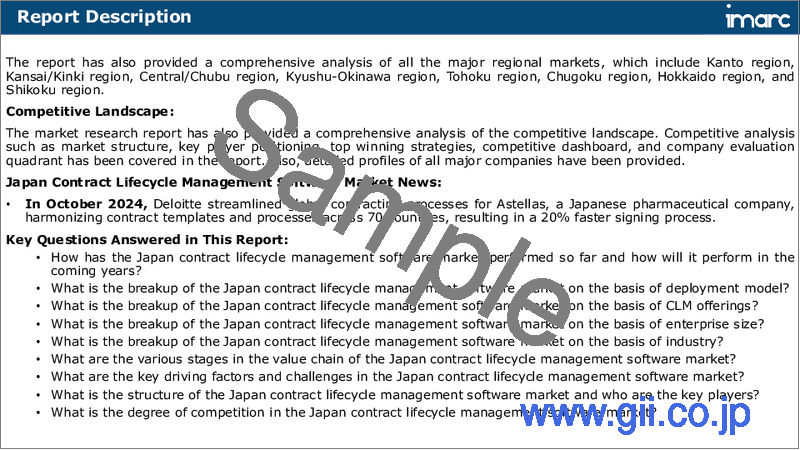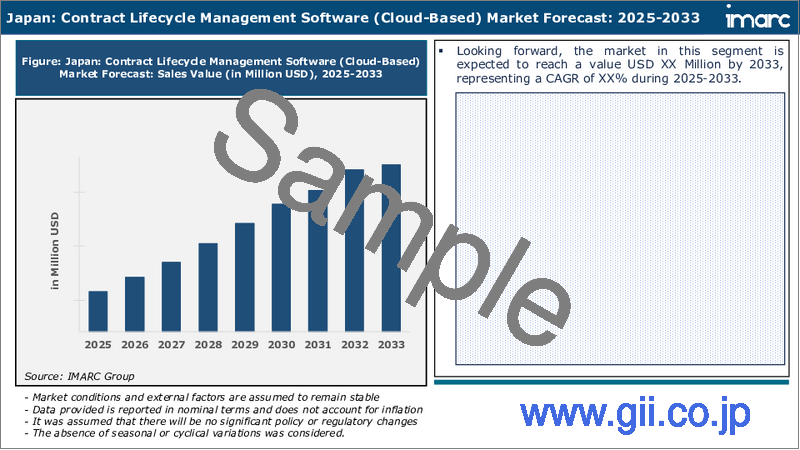|
|
市場調査レポート
商品コード
1747079
日本の契約ライフサイクル管理ソフトウェア市場:市場規模・シェア・動向・予測、展開方式別、CMLの提供内容別、企業規模別、産業別、地域別(2025~2033年)Japan Contract Lifecycle Management Software Market Size, Share, Trends and Forecast by Deployment Model, CLM Offerings, Enterprise Size, Industry, and Region, 2025-2033 |
||||||
カスタマイズ可能
|
|||||||
| 日本の契約ライフサイクル管理ソフトウェア市場:市場規模・シェア・動向・予測、展開方式別、CMLの提供内容別、企業規模別、産業別、地域別(2025~2033年) |
|
出版日: 2025年06月02日
発行: IMARC
ページ情報: 英文 121 Pages
納期: 5~7営業日
|
全表示
- 概要
- 目次
日本の契約ライフサイクル管理 (CLM) ソフトウェアの市場規模は、2024年に1億2,650万米ドルに達しました。今後、IMARC Groupは、同市場が2033年までに3億5,390万米ドルに達し、2025年から2033年にかけて11.20%の成長率(CAGR)を示すと予測しています。デジタルトランスフォーメーション、コンプライアンス要件、契約効率の改善、リスク管理、自動化、データセキュリティ強化に対する需要の高まりは、市場の成長を後押しする要因の一部です。また、金融、医療、製造などの業界全体における採用も市場成長に寄与しています。
当レポートで扱う主な質問
- 日本の契約ライフサイクル管理ソフトウェア市場はこれまでどのように推移し、今後どのように推移するのか?
- 日本の契約ライフサイクル管理ソフトウェア市場の展開方式別の内訳は?
- 日本の契約ライフサイクル管理ソフトウェア市場のCLMの提供内容別の内訳は?
- 日本の契約ライフサイクル管理ソフトウェア市場の企業規模別の内訳は?
- 日本の契約ライフサイクル管理ソフトウェア市場の産業別の内訳は?
- 日本の契約ライフサイクル管理ソフトウェア市場のバリューチェーンにおける各ステージとは?
- 日本の契約ライフサイクル管理ソフトウェア市場の主な促進要因と課題は?
- 日本の契約ライフサイクル管理ソフトウェア市場の構造と主要プレーヤーは?
- 日本の契約ライフサイクル管理ソフトウェア市場の競合状況は?
目次
第1章 序文
第2章 分析範囲・手法
- 分析目的
- ステークホルダー
- データソース
- 市場推定
- 分析手法
第3章 エグゼクティブサマリー
第4章 日本の契約ライフサイクル管理ソフトウェア市場:概要
- 概要
- 市場力学
- 業界動向
- 競合情報
第5章 日本の契約ライフサイクル管理ソフトウェア市場の情勢
- 過去・現在の市場動向(2019~2024年)
- 市場予測(2025~2033年)
第6章 日本の契約ライフサイクル管理ソフトウェア市場:展開方式別の内訳
- クラウドベース
- オンプレミス
第7章 日本の契約ライフサイクル管理ソフトウェア市場:CLMの提供内容別の内訳
- ライセンシング・サブスクリプション
- サービス
第8章 日本の契約ライフサイクル管理ソフトウェア市場:企業規模別の内訳
- 大企業
- 中小企業
第9章 日本の契約ライフサイクル管理ソフトウェア市場:産業別の内訳
- 自動車
- 電気・電子工学
- 医薬品
- 小売業・eコマース
- 製造業
- BFSI
- その他
第10章 日本の契約ライフサイクル管理ソフトウェア市場:競合情勢
- 概要
- 市場構造
- 市場企業のポジショニング
- 主要な成功戦略
- 競合ダッシュボード
- 企業評価象限
第11章 主要企業のプロファイル
第12章 日本の契約ライフサイクル管理ソフトウェア市場:業界分析
- 促進要因・抑制要因・機会
- ポーターのファイブフォース分析
- バリューチェーン分析
第13章 付録
The Japan contract lifecycle management software market size reached USD 126.5 Million in 2024. Looking forward, IMARC Group expects the market to reach USD 353.9 Million by 2033, exhibiting a growth rate (CAGR) of 11.20% during 2025-2033. The increasing demand for digital transformation, compliance requirements, improved contract efficiency, risk management, automation, and enhanced data security are some of the factors propelling the growth of the market. Adoption across industries like finance, healthcare, and manufacturing also contributes to market growth.
Japan Contract Lifecycle Management Software Market Trends:
AI-Driven Contract Management Adoption
The Japan contract lifecycle management (CLM) industry is shifting toward AI-powered solutions that streamline contract management operations. Companies are increasingly using technologies that automate contract development, approval procedures, and post-signature administration, which reduces manual involvement and increases productivity. These AI-powered technologies are intended to improve risk mitigation, increase compliance, and expedite contract execution. As organizations in Japan appreciate the need for optimal contract management, more are looking for solutions that incorporate AI, advanced analytics, and contract intelligence. This transition not only improves operational efficiency but also ensures that firms can handle contracts more efficiently and in accordance with changing legislation, making it a critical priority for enterprises in Japan's expanding legal tech landscape. For example, in August 2024, Sirion partnered with Deloitte India to implement its contract lifecycle management platform across the APAC region, enhancing contract management efficiency for clients, including those in Japan.
Digital Transformation in Contract Management
The market in Japan continues to move toward more integrated and automated contract management systems to boost productivity. These solutions let legal teams handle contracts throughout their lifespan, from development and negotiation to execution and post-signature administration. Businesses are increasingly using these solutions to optimize operations, decrease manual duties, and remain compliant with growing requirements. The transition to digital contract management enables Japanese firms to better manage complicated contracts, improve operational efficiency, and reduce risks. With more law firms and enterprises pursuing digital solutions, the Japanese CLM software market is expected to expand significantly as organizations seek more efficient and technologically advanced contract management systems. For instance, in April 2024, LegalOn Technologies launched its AI-powered LegalOn Cloud service in Japan, designed to assist legal personnel with tasks ranging from contract creation to post-signature management, as well as legal consultations and research. The service marks a significant step in digital contract management. The company also announced a strategic partnership with the Mori Hamada & Matsumoto law firm, further enhancing its offering in the Japanese legal tech market.
Japan Contract Lifecycle Management Software Market Segmentation:
Deployment Model Insights:
- Cloud-Based
- On-Premises
CLM Offerings Insights:
- Licensing and Subscription
- Services
Enterprise Size Insights:
- Large Enterprise
- Small and Medium Enterprise
Industry Insights:
- Automotive
- Electrical and Electronics
- Pharmaceutical
- Retail and E-commerce
- Manufacturing
- BFSI
- Others
Competitive Landscape:
The market research report has also provided a comprehensive analysis of the competitive landscape. Competitive analysis such as market structure, key player positioning, top winning strategies, competitive dashboard, and company evaluation quadrant has been covered in the report. Also, detailed profiles of all major companies have been provided.
Key Questions Answered in This Report:
- How has the Japan contract lifecycle management software market performed so far and how will it perform in the coming years?
- What is the breakup of the Japan contract lifecycle management software market on the basis of deployment model?
- What is the breakup of the Japan contract lifecycle management software market on the basis of CLM offerings?
- What is the breakup of the Japan contract lifecycle management software market on the basis of enterprise size?
- What is the breakup of the Japan contract lifecycle management software market on the basis of industry?
- What are the various stages in the value chain of the Japan contract lifecycle management software market?
- What are the key driving factors and challenges in the Japan contract lifecycle management software market?
- What is the structure of the Japan contract lifecycle management software market and who are the key players?
- What is the degree of competition in the Japan contract lifecycle management software market?
Table of Contents
1 Preface
2 Scope and Methodology
- 2.1 Objectives of the Study
- 2.2 Stakeholders
- 2.3 Data Sources
- 2.3.1 Primary Sources
- 2.3.2 Secondary Sources
- 2.4 Market Estimation
- 2.4.1 Bottom-Up Approach
- 2.4.2 Top-Down Approach
- 2.5 Forecasting Methodology
3 Executive Summary
4 Japan Contract Lifecycle Management Software Market - Introduction
- 4.1 Overview
- 4.2 Market Dynamics
- 4.3 Industry Trends
- 4.4 Competitive Intelligence
5 Japan Contract Lifecycle Management Software Market Landscape
- 5.1 Historical and Current Market Trends (2019-2024)
- 5.2 Market Forecast (2025-2033)
6 Japan Contract Lifecycle Management Software Market - Breakup by Deployment Model
- 6.1 Cloud-Based
- 6.1.1 Overview
- 6.1.2 Historical and Current Market Trends (2019-2024)
- 6.1.3 Market Forecast (2025-2033)
- 6.2 On-Premises
- 6.2.1 Overview
- 6.2.2 Historical and Current Market Trends (2019-2024)
- 6.2.3 Market Forecast (2025-2033)
7 Japan Contract Lifecycle Management Software Market - Breakup by CLM Offerings
- 7.1 Licensing and Subscription
- 7.1.1 Overview
- 7.1.2 Historical and Current Market Trends (2019-2024)
- 7.1.3 Market Forecast (2025-2033)
- 7.2 Services
- 7.2.1 Overview
- 7.2.2 Historical and Current Market Trends (2019-2024)
- 7.2.3 Market Forecast (2025-2033)
8 Japan Contract Lifecycle Management Software Market - Breakup by Enterprise Size
- 8.1 Large Enterprise
- 8.1.1 Overview
- 8.1.2 Historical and Current Market Trends (2019-2024)
- 8.1.3 Market Forecast (2025-2033)
- 8.2 Small and Medium Enterprise
- 8.2.1 Overview
- 8.2.2 Historical and Current Market Trends (2019-2024)
- 8.2.3 Market Forecast (2025-2033)
9 Japan Contract Lifecycle Management Software Market - Breakup by Industry
- 9.1 Automotive
- 9.1.1 Overview
- 9.1.2 Historical and Current Market Trends (2019-2024)
- 9.1.3 Market Forecast (2025-2033)
- 9.2 Electrical and Electronics
- 9.2.1 Overview
- 9.2.2 Historical and Current Market Trends (2019-2024)
- 9.2.3 Market Forecast (2025-2033)
- 9.3 Pharmaceutical
- 9.3.1 Overview
- 9.3.2 Historical and Current Market Trends (2019-2024)
- 9.3.3 Market Forecast (2025-2033)
- 9.4 Retail and E-commerce
- 9.4.1 Overview
- 9.4.2 Historical and Current Market Trends (2019-2024)
- 9.4.3 Market Forecast (2025-2033)
- 9.5 Manufacturing
- 9.5.1 Overview
- 9.5.2 Historical and Current Market Trends (2019-2024)
- 9.5.3 Market Forecast (2025-2033)
- 9.6 BFSI
- 9.6.1 Overview
- 9.6.2 Historical and Current Market Trends (2019-2024)
- 9.6.3 Market Forecast (2025-2033)
- 9.7 Others
- 9.7.1 Historical and Current Market Trends (2019-2024)
- 9.7.2 Market Forecast (2025-2033)
10 Japan Contract Lifecycle Management Software Market - Competitive Landscape
- 10.1 Overview
- 10.2 Market Structure
- 10.3 Market Player Positioning
- 10.4 Top Winning Strategies
- 10.5 Competitive Dashboard
- 10.6 Company Evaluation Quadrant
11 Profiles of Key Players
- 11.1 Company A
- 11.1.1 Business Overview
- 11.1.2 Services Offered
- 11.1.3 Business Strategies
- 11.1.4 SWOT Analysis
- 11.1.5 Major News and Events
- 11.2 Company B
- 11.2.1 Business Overview
- 11.2.2 Services Offered
- 11.2.3 Business Strategies
- 11.2.4 SWOT Analysis
- 11.2.5 Major News and Events
- 11.3 Company C
- 11.3.1 Business Overview
- 11.3.2 Services Offered
- 11.3.3 Business Strategies
- 11.3.4 SWOT Analysis
- 11.3.5 Major News and Events
- 11.4 Company D
- 11.4.1 Business Overview
- 11.4.2 Services Offered
- 11.4.3 Business Strategies
- 11.4.4 SWOT Analysis
- 11.4.5 Major News and Events
- 11.5 Company E
- 11.5.1 Business Overview
- 11.5.2 Services Offered
- 11.5.3 Business Strategies
- 11.5.4 SWOT Analysis
- 11.5.5 Major News and Events
12 Japan Contract Lifecycle Management Software Market - Industry Analysis
- 12.1 Drivers, Restraints, and Opportunities
- 12.1.1 Overview
- 12.1.2 Drivers
- 12.1.3 Restraints
- 12.1.4 Opportunities
- 12.2 Porters Five Forces Analysis
- 12.2.1 Overview
- 12.2.2 Bargaining Power of Buyers
- 12.2.3 Bargaining Power of Suppliers
- 12.2.4 Degree of Competition
- 12.2.5 Threat of New Entrants
- 12.2.6 Threat of Substitutes
- 12.3 Value Chain Analysis





